外研社必修4 Module 3 Body Language and Non-Verbal Communication Reading and Vocabulary(共36张)
文档属性
| 名称 | 外研社必修4 Module 3 Body Language and Non-Verbal Communication Reading and Vocabulary(共36张) | 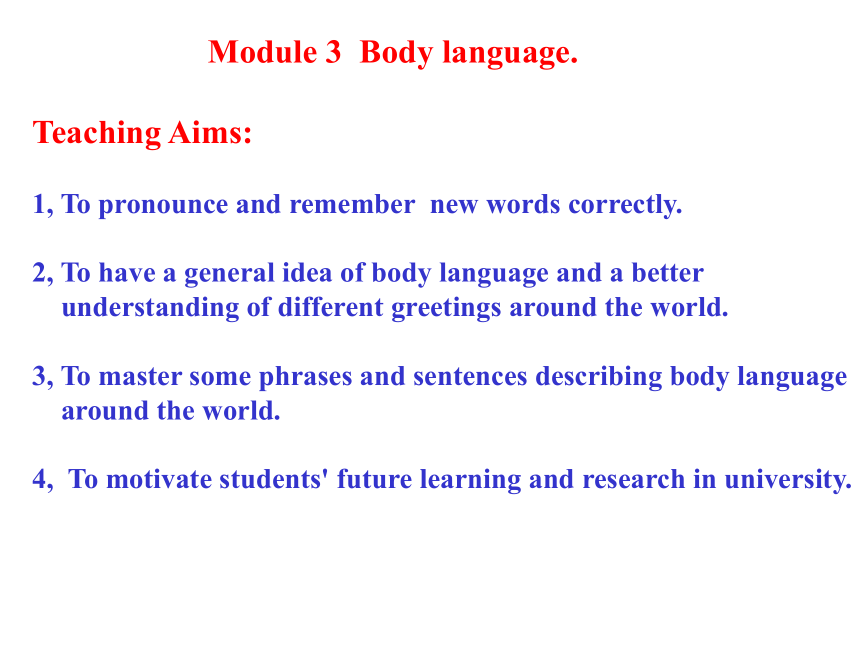 | |
| 格式 | zip | ||
| 文件大小 | 3.0MB | ||
| 资源类型 | 教案 | ||
| 版本资源 | 外研版 | ||
| 科目 | 英语 | ||
| 更新时间 | 2020-04-05 17:46:38 | ||
图片预览


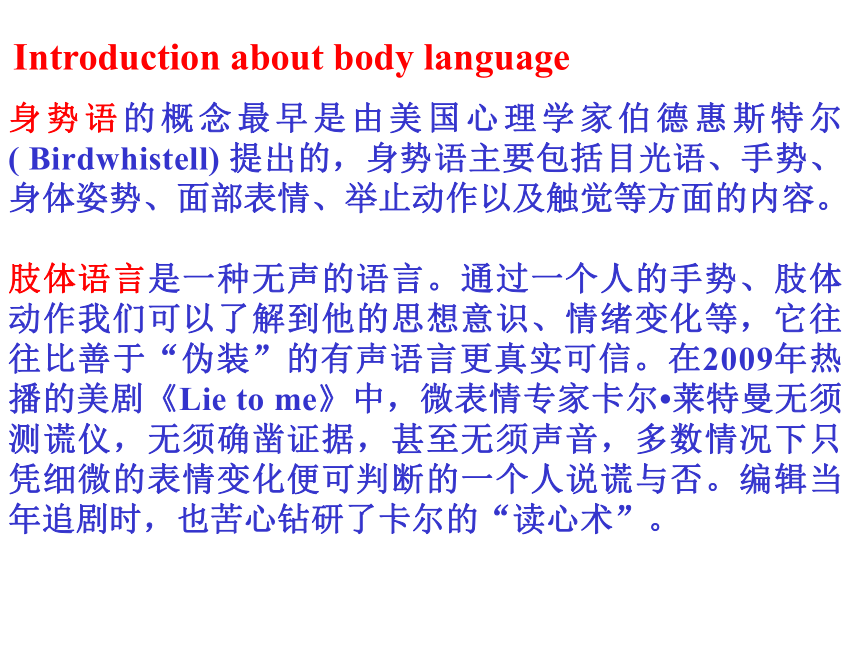
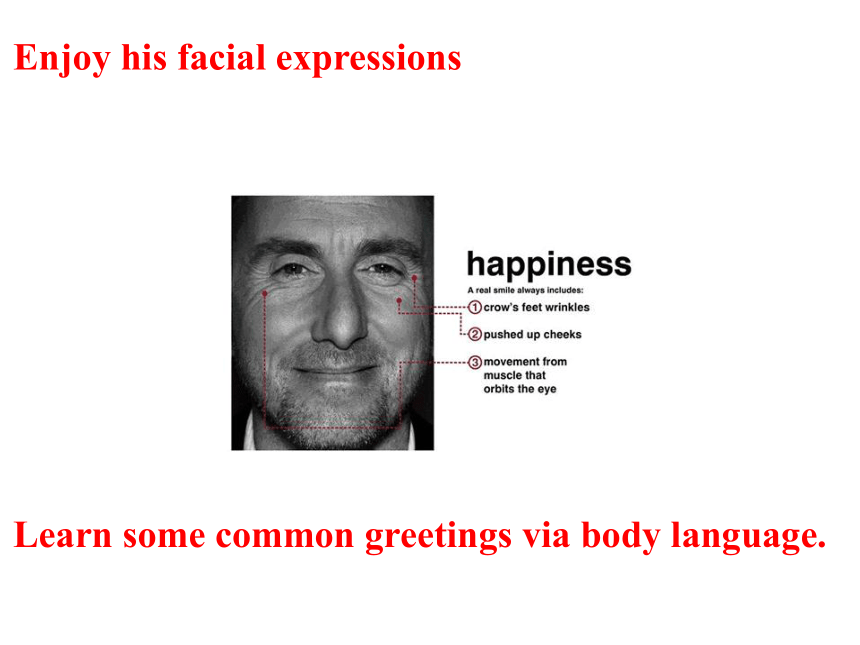
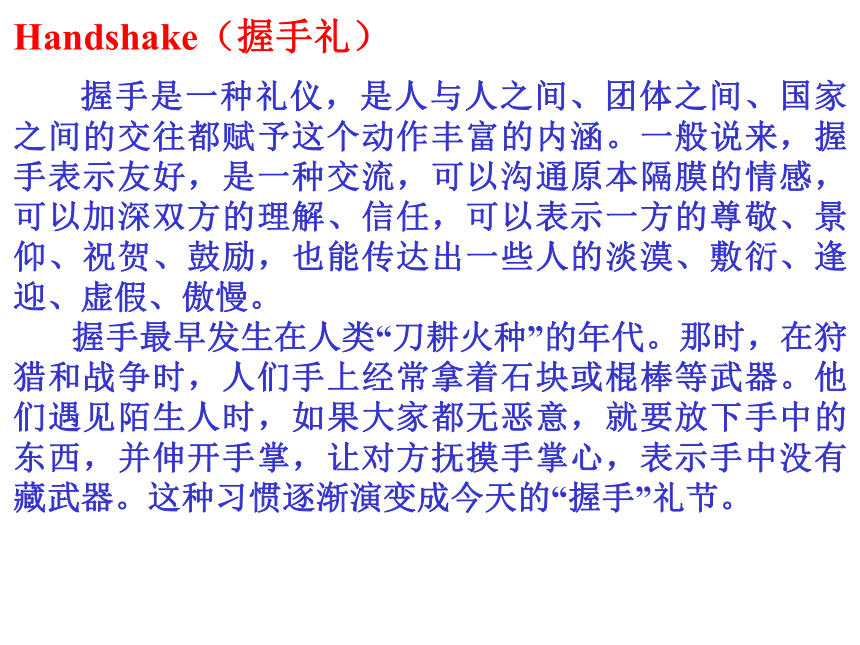
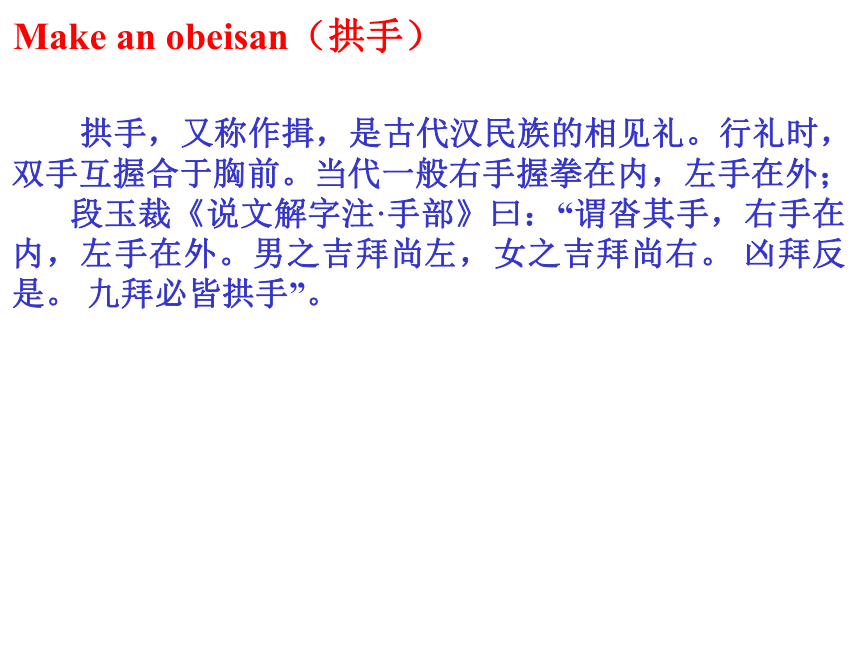
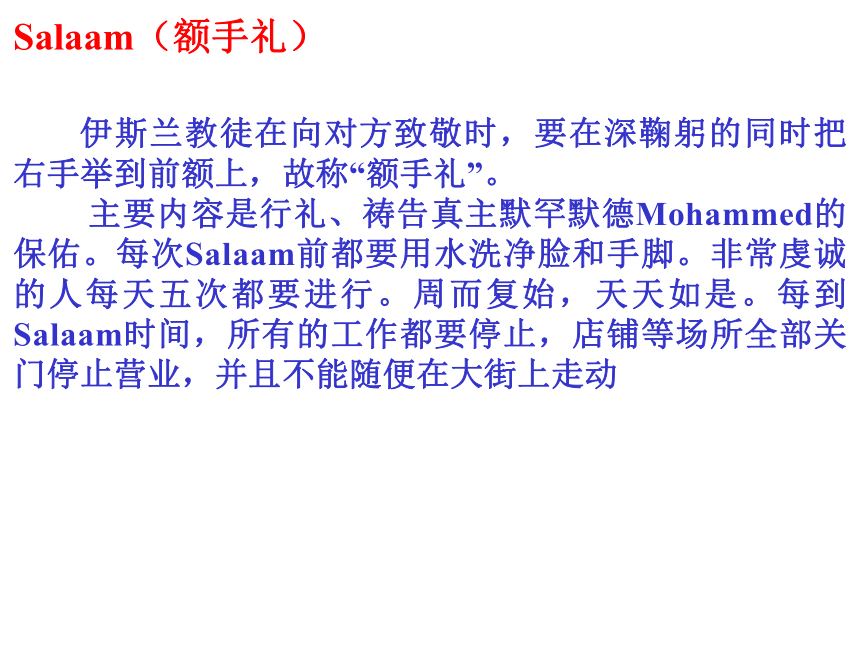
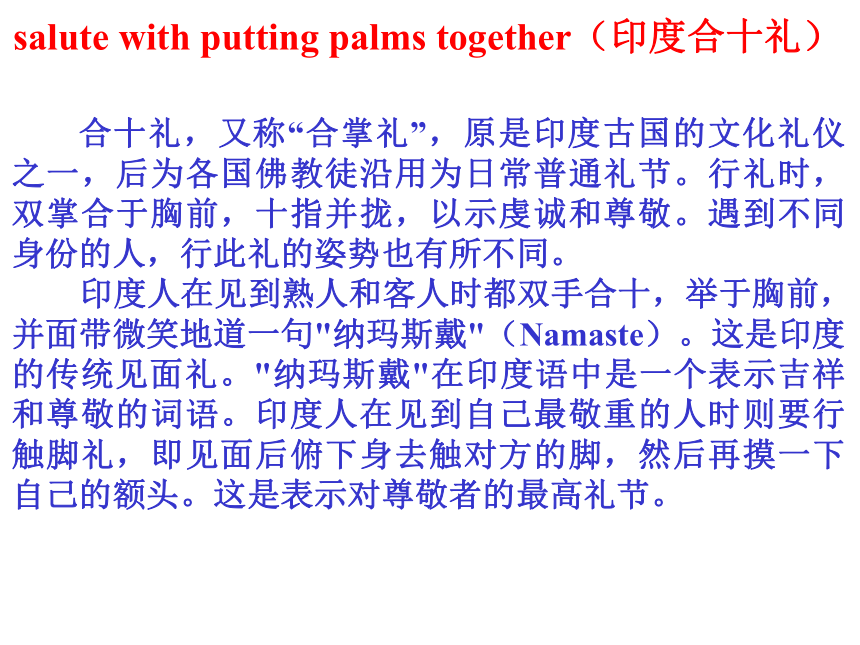
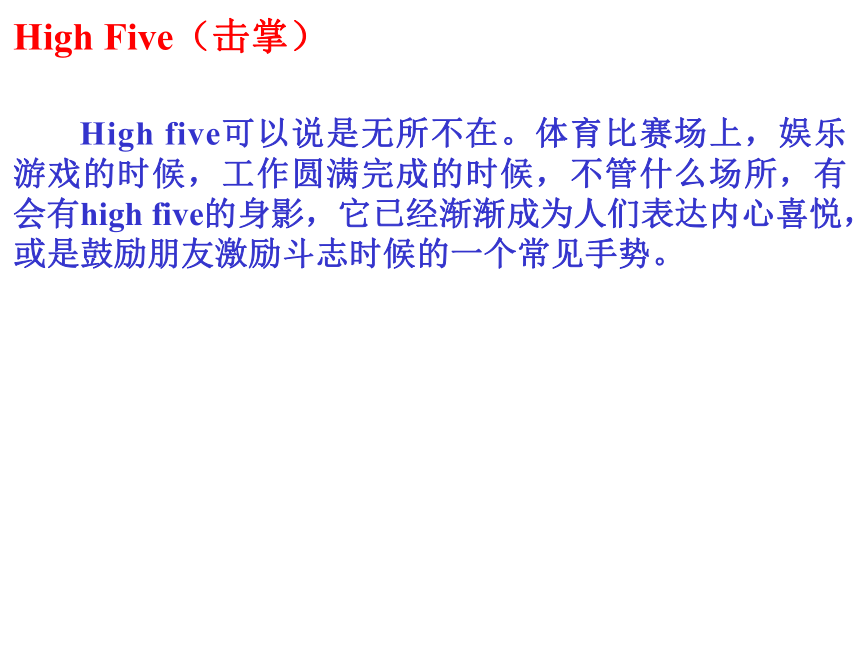


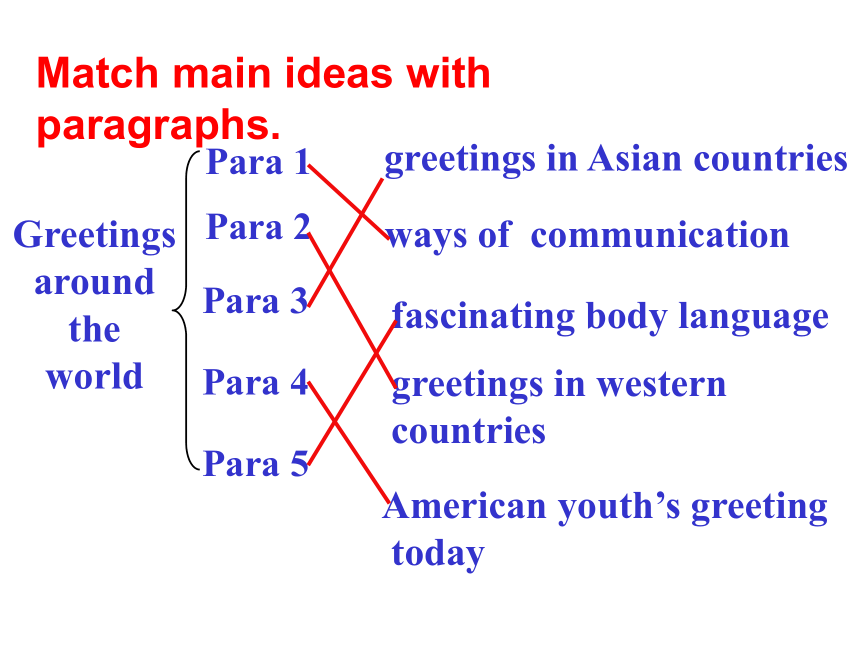
文档简介
(共36张PPT)
Module 3 Body language.
Teaching Aims:
1, To pronounce and remember new words correctly.
2, To have a general idea of body language and a better
understanding of different greetings around the world.
3, To master some phrases and sentences describing body language
around the world.
4, To motivate students' future learning and research in university.
Have a try. Page 114-115.
Read aloud the new words
身势语的概念最早是由美国心理学家伯德惠斯特尔( Birdwhistell) 提出的,身势语主要包括目光语、手势、身体姿势、面部表情、举止动作以及触觉等方面的内容。
肢体语言是一种无声的语言。通过一个人的手势、肢体动作我们可以了解到他的思想意识、情绪变化等,它往往比善于“伪装”的有声语言更真实可信。在2009年热播的美剧《Lie to me》中,微表情专家卡尔?莱特曼无须测谎仪,无须确凿证据,甚至无须声音,多数情况下只凭细微的表情变化便可判断的一个人说谎与否。编辑当年追剧时,也苦心钻研了卡尔的“读心术”。
Introduction about body language
Enjoy his facial expressions
Learn some common greetings via body language.
握手是一种礼仪,是人与人之间、团体之间、国家之间的交往都赋予这个动作丰富的内涵。一般说来,握手表示友好,是一种交流,可以沟通原本隔膜的情感,可以加深双方的理解、信任,可以表示一方的尊敬、景仰、祝贺、鼓励,也能传达出一些人的淡漠、敷衍、逢迎、虚假、傲慢。
握手最早发生在人类“刀耕火种”的年代。那时,在狩猎和战争时,人们手上经常拿着石块或棍棒等武器。他们遇见陌生人时,如果大家都无恶意,就要放下手中的东西,并伸开手掌,让对方抚摸手掌心,表示手中没有藏武器。这种习惯逐渐演变成今天的“握手”礼节。
Handshake(握手礼)
拱手,又称作揖,是古代汉民族的相见礼。行礼时,双手互握合于胸前。当代一般右手握拳在内,左手在外;
段玉裁《说文解字注·手部》曰:“谓沓其手,右手在内,左手在外。男之吉拜尚左,女之吉拜尚右。 凶拜反是。 九拜必皆拱手”。
Make an obeisan(拱手)
伊斯兰教徒在向对方致敬时,要在深鞠躬的同时把右手举到前额上,故称“额手礼”。
主要内容是行礼、祷告真主默罕默德Mohammed的保佑。每次Salaam前都要用水洗净脸和手脚。非常虔诚的人每天五次都要进行。周而复始,天天如是。每到Salaam时间,所有的工作都要停止,店铺等场所全部关门停止营业,并且不能随便在大街上走动
Salaam(额手礼)
合十礼,又称“合掌礼”,原是印度古国的文化礼仪之一,后为各国佛教徒沿用为日常普通礼节。行礼时,双掌合于胸前,十指并拢,以示虔诚和尊敬。遇到不同身份的人,行此礼的姿势也有所不同。
印度人在见到熟人和客人时都双手合十,举于胸前,并面带微笑地道一句"纳玛斯戴"(Namaste)。这是印度的传统见面礼。"纳玛斯戴"在印度语中是一个表示吉祥和尊敬的词语。印度人在见到自己最敬重的人时则要行触脚礼,即见面后俯下身去触对方的脚,然后再摸一下自己的额头。这是表示对尊敬者的最高礼节。
salute with putting palms together(印度合十礼)
High five可以说是无所不在。体育比赛场上,娱乐游戏的时候,工作圆满完成的时候,不管什么场所,有会有high five的身影,它已经渐渐成为人们表达内心喜悦,或是鼓励朋友激励斗志时候的一个常见手势。
High Five(击掌)
Some books related to Body Language
身势学(Kinesics /k??ni?.s?ks/)
伯德惠斯戴尔的理论要点是认为身势语是和人类语言十分相似的一种符号体系。说具体一些,我们往往无意识地皱着眉头,吆五喝六地打着手势,眼睛有时直盯着人,有时却也斜着……这些动作看起来漫不经心,但也和人类的有声语言一样有着特定的含义
Fast reading. Which is the best title?
a. Saying It Without Words
b. When in Rome, Do as the Romans Do
c. Greetings Around the World
d. Read My Mind
Match main ideas with paragraphs.
Greetings
around
the
world
Para 1
Para 2
Para 3
Para 4
Para 5
greetings in Asian countries
ways of communication
fascinating body language
greetings in western
countries
American youth’s greeting
today
Part 1
Part2
Part3
*fascinating body language
*greetings in different countries & areas
*ways of communication
Find the main ideas of
the three parts
Can you design a mind-map or table?
Countries or areas The way of greeting The parts of body involved The meaning of the greeting
Europeans, Americans
China
Muslims
shake hands
the right hand
I trust you…
put the right hand over the left and bow slightly
the hands
show respect
salaam
heart, mouth, forehead
respect
Join their hands and bow their heads
the hands,
head
respect
the hand
say hello
A “high five”
Hindus
American youths
1. Not all body language is conscious.
2. Europeans shake hands with their
left hand.
3. In Asia, people touch strangers
when they meet.
4. In the US a “high five” is a way of
saying hello.
5. A “high five” is a formal gesture.
6. Body language is less communicative
than spoken or written language.
right hand
don’t
touch
an informal
more
Page 23 T or F
aggressive deal gesture greet formal
informal position trust unconscious weapon
1. Guns and knives are two different types of ________.
2. Someone who has a(n) _________ attitude may be violent.
3. You can ________ someone by saying “hello”.
4. Your ________ is the way you are sitting or standing.
5. If you are ___________ of something you do not know it is happening.
weapons
aggressive
greet
position
unconscious
Page 23 Fill in the blanks
aggressive deal gesture greet formal
informal position trust unconscious weapon
6. A(n) ________ is a business agreement.
7. A(n) ________ is a movement of the body to communicate something.
8. If you ________ someone you believe them and rely on them.
9. “Give me five” is a(n) _________ greeting.
10. People are usually more ________ with people they don’t know.
deal
gesture
trust
informal
formal
Para 1
Find the expressions in English
1)身体姿态
2)无意识的身势语
3)习得的身势语
4) 在不同的文化中各不相同
1) body positions
2) unconscious body language
3) learned body language
4) vary from culture to culture
Explanation
communication
words and sentences
body language
unconscious
learned
written
spoken
Para 2
Find the expressions in English
1)保持警觉
2)介绍给陌生人
3)一种向陌生人打招呼的正规的方式
1) be on guard
2) be introduced to strangers
3) a formal way to greet strangers
If our right hand is busing greeting someone, it cannot be holding a weapon, so the gesture is used to express one’s trust.
Why the right hand?
When they are fighting in a war, people
are used to ______________________
because the right hand is
___________________________
hold weapons in the right hand
the strongest hand for most people.
When to shake hands?
greet other people
two occasions
make a deal
Para 3
Find the expressions in English
1)右手放在左手上,拱手,稍稍躬身而行礼。
2)印度人双手交合,恭敬地鞠躬。
1) put the left hand over the right and bow slightly
2) Hindus join their hands and bow their head in
respect.
Muslims
Touch their heart, mouth
and forehead in respect
salaam
Putting the right
hand over the
left
and bow slightly
Ancient Chinese
Hindus
Join their hands
and bow their
head in respect.
Para 4
Find the expressions in English
1)击掌。
2)举起手,手掌向外,五指展开
3) 举起手,拍打对方举过头顶的手
1) give me five
2) hold up his hand, palm ourwards and five fingers spread
3) raise his hand and slaps the other's open hand above the head
American youths
One person holds up his hand, palm
outwards and five fingers spread. The
other person raises his hand and slaps
Para 5
Find the expressions in English
1)身势语对任何研究者来说都有吸引力。
2)人们通过姿势表达的意思要比通过话语表达得更多。
1) Body language is fascinating for anyone to study.
2) People give away much more by their gestures than by their words.
We use both _____ and _____________ to express our thoughts and opinions and to ____________ with other people. Just like spoken language, body language _____ from culture to culture.
words
body language
communicate
varies
Fill in the blanks
Every culture has developed a formal way to ____ strangers. Traditionally, Europeans and Americans ___________. They do this with the _____ hand. That means I trust you. I’m not carrying a __________ weapon.
greet
shake hands
right
threatening
Greetings in _____ countries do not ______ touching the other person, but they always involve the hands.
Asian
involve
Today American youths often greet each other with the expression, “___________!” Body language is fascinating for anyone to study.
People ___a____ much more by
their _______ than by their words.
Give me five
give
away
gestures
You can explore more in university
Module 3 Body language.
Teaching Aims:
1, To pronounce and remember new words correctly.
2, To have a general idea of body language and a better
understanding of different greetings around the world.
3, To master some phrases and sentences describing body language
around the world.
4, To motivate students' future learning and research in university.
Have a try. Page 114-115.
Read aloud the new words
身势语的概念最早是由美国心理学家伯德惠斯特尔( Birdwhistell) 提出的,身势语主要包括目光语、手势、身体姿势、面部表情、举止动作以及触觉等方面的内容。
肢体语言是一种无声的语言。通过一个人的手势、肢体动作我们可以了解到他的思想意识、情绪变化等,它往往比善于“伪装”的有声语言更真实可信。在2009年热播的美剧《Lie to me》中,微表情专家卡尔?莱特曼无须测谎仪,无须确凿证据,甚至无须声音,多数情况下只凭细微的表情变化便可判断的一个人说谎与否。编辑当年追剧时,也苦心钻研了卡尔的“读心术”。
Introduction about body language
Enjoy his facial expressions
Learn some common greetings via body language.
握手是一种礼仪,是人与人之间、团体之间、国家之间的交往都赋予这个动作丰富的内涵。一般说来,握手表示友好,是一种交流,可以沟通原本隔膜的情感,可以加深双方的理解、信任,可以表示一方的尊敬、景仰、祝贺、鼓励,也能传达出一些人的淡漠、敷衍、逢迎、虚假、傲慢。
握手最早发生在人类“刀耕火种”的年代。那时,在狩猎和战争时,人们手上经常拿着石块或棍棒等武器。他们遇见陌生人时,如果大家都无恶意,就要放下手中的东西,并伸开手掌,让对方抚摸手掌心,表示手中没有藏武器。这种习惯逐渐演变成今天的“握手”礼节。
Handshake(握手礼)
拱手,又称作揖,是古代汉民族的相见礼。行礼时,双手互握合于胸前。当代一般右手握拳在内,左手在外;
段玉裁《说文解字注·手部》曰:“谓沓其手,右手在内,左手在外。男之吉拜尚左,女之吉拜尚右。 凶拜反是。 九拜必皆拱手”。
Make an obeisan(拱手)
伊斯兰教徒在向对方致敬时,要在深鞠躬的同时把右手举到前额上,故称“额手礼”。
主要内容是行礼、祷告真主默罕默德Mohammed的保佑。每次Salaam前都要用水洗净脸和手脚。非常虔诚的人每天五次都要进行。周而复始,天天如是。每到Salaam时间,所有的工作都要停止,店铺等场所全部关门停止营业,并且不能随便在大街上走动
Salaam(额手礼)
合十礼,又称“合掌礼”,原是印度古国的文化礼仪之一,后为各国佛教徒沿用为日常普通礼节。行礼时,双掌合于胸前,十指并拢,以示虔诚和尊敬。遇到不同身份的人,行此礼的姿势也有所不同。
印度人在见到熟人和客人时都双手合十,举于胸前,并面带微笑地道一句"纳玛斯戴"(Namaste)。这是印度的传统见面礼。"纳玛斯戴"在印度语中是一个表示吉祥和尊敬的词语。印度人在见到自己最敬重的人时则要行触脚礼,即见面后俯下身去触对方的脚,然后再摸一下自己的额头。这是表示对尊敬者的最高礼节。
salute with putting palms together(印度合十礼)
High five可以说是无所不在。体育比赛场上,娱乐游戏的时候,工作圆满完成的时候,不管什么场所,有会有high five的身影,它已经渐渐成为人们表达内心喜悦,或是鼓励朋友激励斗志时候的一个常见手势。
High Five(击掌)
Some books related to Body Language
身势学(Kinesics /k??ni?.s?ks/)
伯德惠斯戴尔的理论要点是认为身势语是和人类语言十分相似的一种符号体系。说具体一些,我们往往无意识地皱着眉头,吆五喝六地打着手势,眼睛有时直盯着人,有时却也斜着……这些动作看起来漫不经心,但也和人类的有声语言一样有着特定的含义
Fast reading. Which is the best title?
a. Saying It Without Words
b. When in Rome, Do as the Romans Do
c. Greetings Around the World
d. Read My Mind
Match main ideas with paragraphs.
Greetings
around
the
world
Para 1
Para 2
Para 3
Para 4
Para 5
greetings in Asian countries
ways of communication
fascinating body language
greetings in western
countries
American youth’s greeting
today
Part 1
Part2
Part3
*fascinating body language
*greetings in different countries & areas
*ways of communication
Find the main ideas of
the three parts
Can you design a mind-map or table?
Countries or areas The way of greeting The parts of body involved The meaning of the greeting
Europeans, Americans
China
Muslims
shake hands
the right hand
I trust you…
put the right hand over the left and bow slightly
the hands
show respect
salaam
heart, mouth, forehead
respect
Join their hands and bow their heads
the hands,
head
respect
the hand
say hello
A “high five”
Hindus
American youths
1. Not all body language is conscious.
2. Europeans shake hands with their
left hand.
3. In Asia, people touch strangers
when they meet.
4. In the US a “high five” is a way of
saying hello.
5. A “high five” is a formal gesture.
6. Body language is less communicative
than spoken or written language.
right hand
don’t
touch
an informal
more
Page 23 T or F
aggressive deal gesture greet formal
informal position trust unconscious weapon
1. Guns and knives are two different types of ________.
2. Someone who has a(n) _________ attitude may be violent.
3. You can ________ someone by saying “hello”.
4. Your ________ is the way you are sitting or standing.
5. If you are ___________ of something you do not know it is happening.
weapons
aggressive
greet
position
unconscious
Page 23 Fill in the blanks
aggressive deal gesture greet formal
informal position trust unconscious weapon
6. A(n) ________ is a business agreement.
7. A(n) ________ is a movement of the body to communicate something.
8. If you ________ someone you believe them and rely on them.
9. “Give me five” is a(n) _________ greeting.
10. People are usually more ________ with people they don’t know.
deal
gesture
trust
informal
formal
Para 1
Find the expressions in English
1)身体姿态
2)无意识的身势语
3)习得的身势语
4) 在不同的文化中各不相同
1) body positions
2) unconscious body language
3) learned body language
4) vary from culture to culture
Explanation
communication
words and sentences
body language
unconscious
learned
written
spoken
Para 2
Find the expressions in English
1)保持警觉
2)介绍给陌生人
3)一种向陌生人打招呼的正规的方式
1) be on guard
2) be introduced to strangers
3) a formal way to greet strangers
If our right hand is busing greeting someone, it cannot be holding a weapon, so the gesture is used to express one’s trust.
Why the right hand?
When they are fighting in a war, people
are used to ______________________
because the right hand is
___________________________
hold weapons in the right hand
the strongest hand for most people.
When to shake hands?
greet other people
two occasions
make a deal
Para 3
Find the expressions in English
1)右手放在左手上,拱手,稍稍躬身而行礼。
2)印度人双手交合,恭敬地鞠躬。
1) put the left hand over the right and bow slightly
2) Hindus join their hands and bow their head in
respect.
Muslims
Touch their heart, mouth
and forehead in respect
salaam
Putting the right
hand over the
left
and bow slightly
Ancient Chinese
Hindus
Join their hands
and bow their
head in respect.
Para 4
Find the expressions in English
1)击掌。
2)举起手,手掌向外,五指展开
3) 举起手,拍打对方举过头顶的手
1) give me five
2) hold up his hand, palm ourwards and five fingers spread
3) raise his hand and slaps the other's open hand above the head
American youths
One person holds up his hand, palm
outwards and five fingers spread. The
other person raises his hand and slaps
Para 5
Find the expressions in English
1)身势语对任何研究者来说都有吸引力。
2)人们通过姿势表达的意思要比通过话语表达得更多。
1) Body language is fascinating for anyone to study.
2) People give away much more by their gestures than by their words.
We use both _____ and _____________ to express our thoughts and opinions and to ____________ with other people. Just like spoken language, body language _____ from culture to culture.
words
body language
communicate
varies
Fill in the blanks
Every culture has developed a formal way to ____ strangers. Traditionally, Europeans and Americans ___________. They do this with the _____ hand. That means I trust you. I’m not carrying a __________ weapon.
greet
shake hands
right
threatening
Greetings in _____ countries do not ______ touching the other person, but they always involve the hands.
Asian
involve
Today American youths often greet each other with the expression, “___________!” Body language is fascinating for anyone to study.
People ___a____ much more by
their _______ than by their words.
Give me five
give
away
gestures
You can explore more in university
